
My Top 10 Video Games of “2019”
By Brian • 29 January 2020
Check it out! A somewhat timely Top 10 Games of the Year list! By comparison, the 2018 list didn’t release until May of 2019. I’m on a roll. The Pulitzer for online rambling lies within reach!
Although, I must admit, assembling a list of ten whole games played in 2019 proved challenging! I spent fewer hours playing video games in 2019 than any year in recent memory, so I had to cheat a little bit here and there to present a full list. Normally, I don’t include games I’ve beaten prior to the year in question, with the exception of the game in the “Honorable Mention” slot. Well, in this case, I included a game I beat for the first time many years ago, but spent quite a bit of time revisiting in 2019. Sacrilege. Perhaps I’ll redeem myself in 2020. Or maybe I’ll play fewer games than ever?! Such drama in this life of mine, let me tell you. Let’s check out the list before the gaming melodrama reaches levels from which we cannot recover!
As always, the games on this list didn’t have to be released in 2019 (hence the quotation marks in the title), just that I either beat them or played the majority of them in 2019.
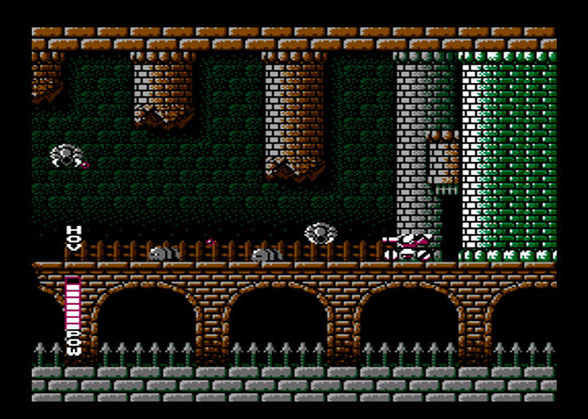
Honorable Mention: Blaster Master (NES, 1988)
Among the games that I would consider to be my favorites on the NES, Blaster Master has long been the only game on that list that I cannot beat legitimately. I have only seen the end via gross abuse of save states. After its release on Nintendo Switch Online in January of 2019, I tried, once again, to defeat Blaster Master without rampant cheating. Annnddd…it’s still the single, unconquered entry among my favorite NES games. What is by and large a great game is cursed by its own upgrade system—the more movement upgrades the tank receives, the harder it controls. For instance, late in the game, the tank gains the ability to drive on walls. Unfortunately, this makes driving to an edge and then jumping off of it much trickier than it should be. (Yes, of course the tank jumps. It’s an NES game.) Instead, the tank will turn down the edge, often into a bed of spikes or some other hazard that I intended to jump across. It gets frustrating, especially in the tight, obstacle-laden corridors of the final area. It’s a detriment to an otherwise fun and amazing experience. Some day, Blaster Master. Some day.
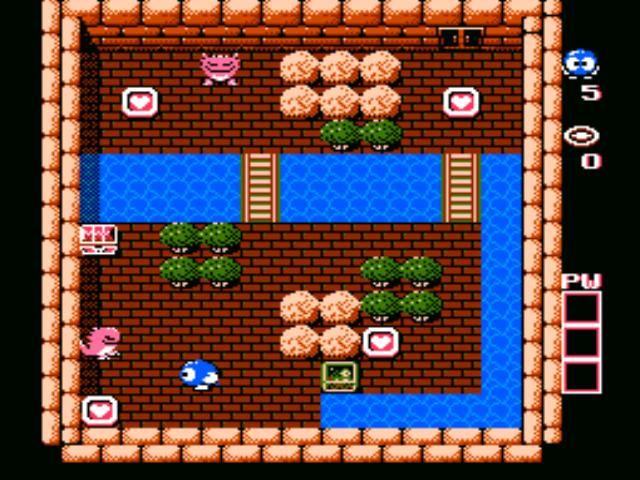
10. Adventures of Lolo (NES, 1989)
I can’t say that block-pushing puzzle games often make my Top 10 lists, but Adventures of Lolo is a stand-out of the genre. Pushing blocks to save the princess (and probably build biceps) has never felt better. It has a nice aesthetic, a dare-I-say perfect learning curve, a single piece of music that plays through nearly the entire game, but somehow doesn’t get old, and it’s one of the late Satoru Iwata’s successes from his time at HAL Laboratory. Since Iwata found his way into all of our hearts as Nintendo’s president and CEO, playing any of his works fills me with a sense of joy and peace. I know that probably sounds ridiculous, but it’s the truth. Lolo is no exception.
For a quick, casual, relaxing, pick-up-and-play puzzle experience, you can check out Adventures of Lolo among the NES games available on Nintendo Switch Online.

9. Mutant Mudds Deluxe (Switch, 2013)
Mutant Mudds is another quick and casual game that appropriately made my list in what proved to be a busy and stressful year. It’s a 2D platformer in which Max defends the planet against an invasion of mutant mud monsters with his trusty water gun and jetpack. The gimmick here is that at certain points in each level, Max can jump into the foreground or background to battle more aliens, find secrets, and try to collect all 100 coins. It starts off easy, but the difficulty ramps up to near-frustrating levels later in the game, and there’s also a “dark world” of sorts that I have not yet completed, but thus far, its difficulty and atmosphere are reminiscent of Super Meat Boy’s dark world, which is something I’d rather not revisit. I hope Mutant Mudds is a bit more forgiving. I completed the main game in a fairly solid chunk and am now tackling the dark world and the bonus content bit by bit, when I might have 15 minutes left in the day.
As I played Mutant Mudds, I got strong vibes of early PC platformers such as Commander Keen and Duke Nukem, games that emphasize shooting and jumping and grabbing tons of items for points. Max and Keen would make great next-door neighbors, what with their gadgets, kid-friendly games, and penchant for battling aliens. Mutant Mudds is worth a try, and the Mutant Mudds Collection, which includes Mutant Mudds Deluxe, Mutant Mudds Super Challenge, and Mudd Blocks, is frequently on sale for around $1.50, so you won’t break the bank giving this a shot.

8. Sega Ages: Phantasy Star (Switch, 1987)
Truth be told, I haven’t finished this one, yet. Come on, give me a break—Phantasy Star is grind city and you know it. No self-respecting roleplaying game from the 80s would expect any less than hours upon hours of battles to earn a paltry sum of money and barely enough experience to reach the next level.
Actually, this being the Sega Ages version of Phantasy Star, the grind isn’t that bad. Enemies award much more gold and experience, making the gameplay more palatable and less time-consuming, especially for the modern dad gamer with serious time restraints. I remember trying to play the original version of Phantasy Star—I swear I put in ten hours of eking out fights against weak insects before I could go anywhere or do anything without getting pasted by the tougher monsters. It was…fun? But even then, as a teenager, I felt like I didn’t have the time to play it. The Sega Ages version also auto-maps the dungeons, which are winding labyrinths navigated in first-person view. These dungeons are almost inescapable without drawing a map (or looking one up online), so the auto-mapping is a treasure beyond any actual loot found in the mazes.
Phantasy Star has that certain anime-influenced sci-fi/fantasy setting that I like, combining swords and robots, plus some space travel and magic and cool vehicles, too. There’s something about sci-fi RPGs that tickles me just right, but I honestly haven’t played that many of them. But, based on what I’ve seen from Phantasy Star thus far, I definitely want to finish it and check out its sequels, which have flown under my radar for too long.
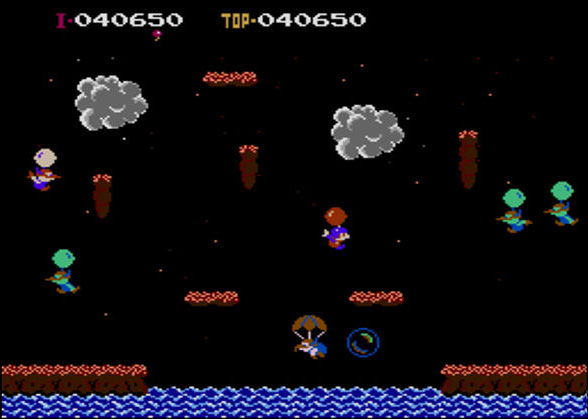
7. Balloon Fight (NES, 1986)
Like Adventures of Lolo, Balloon Fight is another NES game that can be found on Nintendo Switch Online. It, too, was programmed by Satoru Iwata. At its core, it’s a Joust clone, but that’s not a bad thing! Balloon Fight sets itself apart from its inspiration with its own nuances and unique qualities. The goal remains the same: knock your opponents out of the sky, then boot them off the screen for points. In this case, knocking them out of the sky involves popping their balloons, rather than dismounting them from flying ostriches. Lightning hazards in the clouds and giant, creepy fish that will attempt to drag low-flying balloon fighters into the water keep the dogfights unpredictable and plenty dangerous. An alternate, single-player-only game mode called Balloon Trip, in which the player must dodge sparks of lightning and grab as many balloons as possible for a high score, adds some depth and variety to the already fun gameplay.
The best part of Balloon Fight, of course, is the 2-player mode, which I played a lot with my brother thanks to the magic of Nintendo Switch Online. Well, it was magical so long as my questionable internet connection didn’t drag down the fun via immense lag. The Switch Online service might also be partly to blame, as it had its own connectivity issues from time to time. However, as long as the gameplay was smooth, playing online with Craig was a blast!
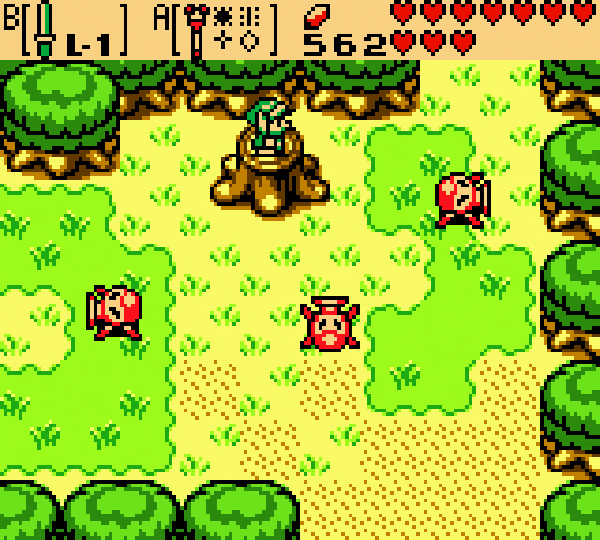
6. The Legend of Zelda: Oracle of Seasons (Game Boy Color, 2001)
My seemingly unending campaign to complete all the Legend of Zelda games (well, almost all of them) continued in 2019 with Oracle of Seasons. I completed its companion game, Oracle of Ages, a few years back, and the two games can link up to one another in a few curious ways, provided you have the right peripherals to do so. I do not, but that’s okay! Also, I got a code for beating Oracle of Ages that I think I was supposed to put in before starting Oracle of Seasons, but I, a big dumb-dumb, failed to do that, so I won’t get the good ending. Whoops!
Anyway, seeing that this game is built on the Link’s Awakening engine, it’s pretty awesome by default. On top of that, there is a fun and fitting season-changing mechanic that solves a multitude of puzzles. The game’s antagonist throws the world’s seasons out of whack, so winter reigns one area, summer in another, and so on. But, Link has a wand he can use to change the seasons. So, if a big pile of snow blocks a cave entrance, Link can summon the power of seasons, change winter to spring, and now the cave is accessible. Naturally, the game is full of puzzles like these, but they all seemlogical and well placed, and make for a fun experience. The dungeons struck me as a little weak in this installment, but otherwise, I can’t complain. I haven’t finished this one just yet (shame of shames), but I’m far enough in that I can’t turn back.
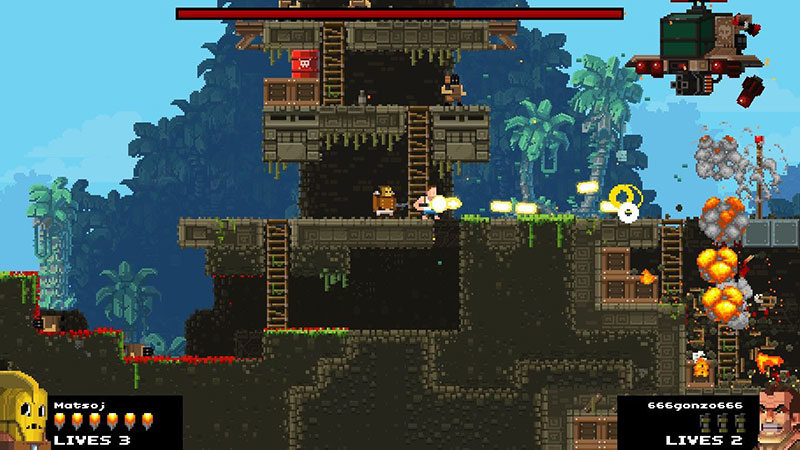
5. Broforce (PC, 2015)
I must admit—it took some time for Broforce to grow on me. My brother bought this one for me so we could have another co-op adventure to play together, and at first, I just didn’t get it. It should have fit snugly in my wheelhouse, playing as a cavalcade of action movie icons—Rambo, the Terminator, good grief, even Timecop is here—shooting up guerillas, demons, aliens, and more. But, it wasn’t quite what I expected. For one, I figured I would be able to choose my character, but they are assigned randomly, which jarred me, at first. However, the more time put into Broforce, and the more rescues made, the more characters unlock, which makes things quite a bit more interesting. By the end of the game, we had unlocked dozens of action movie stars, so we were never sure what crazy character was going to fall under our control next. I thought it added excitement and anticipation to the game.
I also envisioned Contra-style, run-and-gun gameplay. You do run and gun, don’t get me wrong, but it’s much more destructive and strategic. The level layouts offer lots of towers and bunkers and twists and turns to navigate, and all of the environments are destructible, which worked to both our advantage and disadvantage. Shooting a box of explosives might quickly eliminate a room full of bad guys, but it might also create a chasm too wide to jump across. Planning is important, but the action is at times so intense that we could only do so much. Sometimes working hastily to get out of a jam created bigger problems. I feel like there’s sort of an allegory here for real life. Nah, surely not.
Anyway, with most of the characters unlocked, figuring out the game mechanics, and embracing the sheer absurdity of the premise, I was hooked by Broforce. It’s a love letter to action movies and television, and I suspect children of the 80s and 90s everywhere ought to be enamored with this one.

4. The Legend of Zelda: Link’s Awakening (Switch, 2019)
It’s probably been 20 years since I last played Link’s Awakening or Link’s Awakening DX, so the Switch remake of this Legend of Zelda classic arrived with fortuitous timing. Honestly, I beat it a little too quickly—I was shocked at how much I remembered from the original. Aside from that, I recommend the remake over the original. It improves the original formula in almost every way, from streamlined item-swapping, less verbose in-game instructions, to the addition of more secrets and collectibles. The fishing mini-game awards Link with more goodies and a more in-depth experience, too. Which, if you’re looking for a quick way into my heart, a good fishing mini-game is a viable way to do it.
I don’t have an official “Favorite Zelda Games” list, but Link’s Awakening is top-5 or 6 material. If you’ve never played the original or the DX version, or if even if you have, get yourself this remake and have a good time!
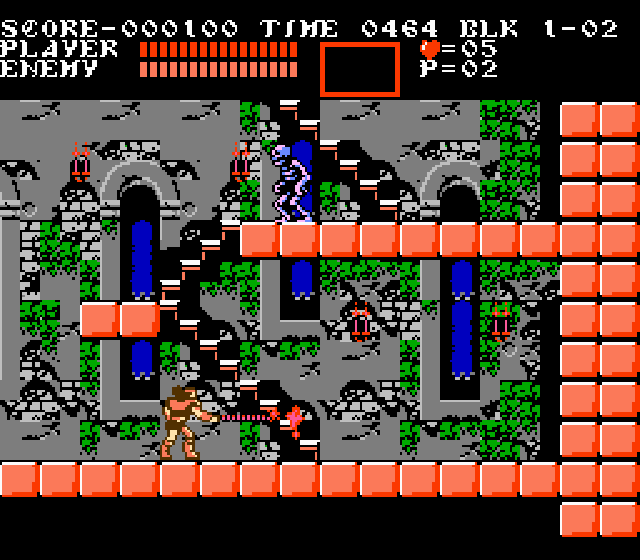
3. Castlevania III: Dracula’s Curse (NES, 1990)
Castlevania III features the ability to recruit one of three characters in Trevor Belmont’s quest to crush Dracula: Grant Danasty, a rogue; Sypha Belnades, a wizard; and Alucard, rebellious half-human son of Dracula. By pushing the select button, the player can switch between Trevor and his second, each with his or her own special abilities, strengths, and weaknesses. The downside is that only one character can accompany Trevor at any time. However, the good news is that this creates plenty of opportunity for replayability.
For the longest time, the only way I’d ever beaten Castlevania 3 was the Trevor/Sypha combo. I call it “easy mode,” as Sypha possesses strong magic spells that make many late-game boss fights a breeze. (Well, relatively speaking. This is Castlevania we’re talking about, one of the most notoriously difficult franchises in video game history.) In 2018, I completed a solo run with just Trevor, and finally, last year, I completed the set by beating the game as Trevor/Grant and Trevor/Alucard. Any time I play Castlevania III, I’m tempted to just go the Sypha route, but beating the game with Grant and Alucard forced me to try some new things, play more strategically, master earning double and triple shots for subweapons, and otherwise stop using Sypha as a crutch. I hadn’t put this much time and effort into Castlevania 3 since I got it for my birthday all the way back in 1991 or 1992, and I had a great time exploring aspects of the game I’d largely ignored.
Depending on my mood, Castlevania III is my favorite NES game of all time. So why isn’t it #1 on this list? Well, the simple answer is that my rankings aren’t an exact science. But, being among my favorites and thirty years old (yikes), It’s also a game I’ve played to death, so there are other games on this list that I was honestly more excited to play at this time in my life, despite the fact that, in the big picture, I probably don’t like them as much as Castlevania III. I hope that makes sense. If not, I’m sure the president of online video game rankings will be happy to kick me out of the guild.

2. Bloodstained: Curse of the Moon (Switch, 2018)
Speaking of Castlevania III, it’s only appropriate that Bloodstained: Curse of the Moon is on the same list—it draws heavy inspiration from Castlevania III, including 8-bit art style, stairs-based platforming, and four playable characters with distinct skill sets, advantages, and disadvantages. It seems quite a bit easier than Castlevania III, as well, but that is not unwelcome. The length of the game fit my life perfectly, branching paths criss cross each level, which may or may not be accessible depending on the characters at your disposal, and the player’s decisions throughout the game impact the ending and can unlock new game modes, as well. Everything feels well constructed and thought out, and the boss designs and music delight the senses.
Even though Curse of the Moon is highly derivative of something that already exists, and is also a companion piece to a much bigger game, Bloodstained: Ritual of the Night, it still manages to create and settle in to its own identity. It’s a standalone experience from Ritual of the Night, and since I haven’t played that game, yet, I can tell you that Curse of the Moon is worth your attention on its own.
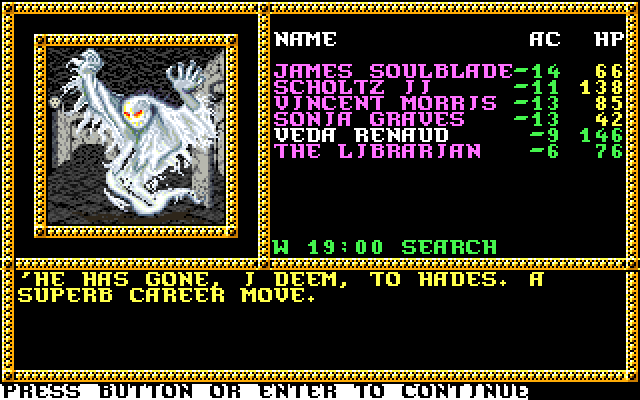
1. AD&D: Pools of Darkness (PC, 1991)
Well, I did write an entire blog series about Pools of Darkness, so I would hope it finished #1.
Here’s the thing about Pools of Darkness. It’s not the best RPG of all time. Heck, I don’t even know if it’s the best game in the series to which it belongs. It is, however, the end of a long journey. As the final game of a 4-part epic, Pools of Darkness brings closure to a heavy sum of unbelievable adventures taken on by a small party of “heroes” introduced as level-1 scrubs in Pool of Radiance, barely surviving encounters with kobolds and drunks in the tavern. Their adventures continue in Curse of the Azure Bonds and Secret of the Silver Blades as the party strives against more and more impossible odds, piling up victories against dragons and giants and other terrific horrors. By the end of Pools of Darkness, our once-novice heroes, now pushing level 40, can level entire armies—which they’ll have to do, as the evil god Bane goes all-in on a final attempt to eliminate them and rule the Forgotten Realms forever. The series offers the remarkable ability to transfer the same party of adventurers from game to game, forging a true bond between player and avatars as they carry on through four huge adventures. By the time the dust settled and Pools of Darkness lay defeated, I felt a genuine (and honestly a little weird) pride in my party, and happiness for them because they could finally retire. Not many games come to mind that have left me with that kind of feeling. Final Fantasy VI, perhaps. But I can’t think of much else.
Oh, the gameplay is good, too. I guess that’s worth mentioning. The immersive story spans the entire Moonsea region, the strategic combat never stops being fun, and the roleplaying, while not dripping with consequences, kept me engaged and thoughtful of my actions. Plus, after owning the game for 28 years or whatever, it felt great to finally finish it.